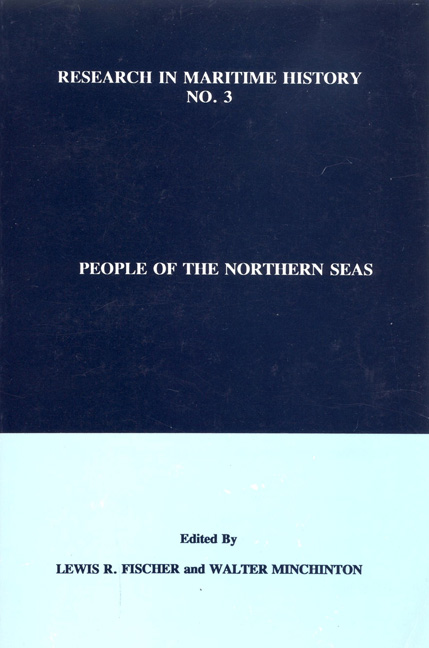Book contents
- Frontmatter
- Contents
- About the Editors
- Contributors
- General Introduction
- “Une Petite Republique” in Southwestern Newfoundland: The Limits of Imperial Authority in a Remote Maritime Environment”
- “Changes in Aleut Communities Following Russian Contact”
- “Five Years Before the Mast: Observations on the Conditions of Maritime Labour in Finland and Elsewhere”
- “Expressions of Longing, Sources of Anxiety? The Significance of Contacts with Home for Finnish Sailors in London and Hull in the Late Nineteenth Century”
- “Death of a Merchant”
- “St. Petersburg's Bills of Exchange in the Russian Economy of the Eighteenth Century”
- “Shipowners and Iron Sailing Ships: The First Twenty Years, 1838-1857”
- “The Growth of Norwegian Shipbroking: The Practices of Fearnley and Eger as a Case Study, 1869-1914”
- “Captain John Deane: Mercenary, Diplomat and Spy”
- “Her Majesty's Coastguard”
- “Coastal Life, ‘Nordic Culture’ and Nation State: Reflections on the Formation of the Nation State and Maritime History”
“Expressions of Longing, Sources of Anxiety? The Significance of Contacts with Home for Finnish Sailors in London and Hull in the Late Nineteenth Century”
- Frontmatter
- Contents
- About the Editors
- Contributors
- General Introduction
- “Une Petite Republique” in Southwestern Newfoundland: The Limits of Imperial Authority in a Remote Maritime Environment”
- “Changes in Aleut Communities Following Russian Contact”
- “Five Years Before the Mast: Observations on the Conditions of Maritime Labour in Finland and Elsewhere”
- “Expressions of Longing, Sources of Anxiety? The Significance of Contacts with Home for Finnish Sailors in London and Hull in the Late Nineteenth Century”
- “Death of a Merchant”
- “St. Petersburg's Bills of Exchange in the Russian Economy of the Eighteenth Century”
- “Shipowners and Iron Sailing Ships: The First Twenty Years, 1838-1857”
- “The Growth of Norwegian Shipbroking: The Practices of Fearnley and Eger as a Case Study, 1869-1914”
- “Captain John Deane: Mercenary, Diplomat and Spy”
- “Her Majesty's Coastguard”
- “Coastal Life, ‘Nordic Culture’ and Nation State: Reflections on the Formation of the Nation State and Maritime History”
Summary
“Klingar icke modersmálet skônast, Binder cj ditt hem med dubbia gara, Lyser icke själva graset grönast Pi den tuva dar du lekt som barn?”
Is not your mother tongue the sweetest, Does not your home with double ties you tie, And surely grass must shine the greenest on the fields you walked in days gone by?
The text above was embroidered by a young girl from the Àland Islands in 1906 on a wall tapestry for her fiancee and accompanied the seaman (later captain) for the next thirty years as a reminder of home and those who awaited his return. This story neatly summarizes an established, if somewhat idyllic, view of the emotional bonds between seaman and home: that at the bottom of the itinerant mariner's heart was a constant longing for hearth and kin. While this perception has some foundation, merchant seafaring not only made it difficult to have a permanent abode but also loosened or severed the seaman's ties with his birthplace. A good indication of the scale of this problem is an 1886 estimate that onethird of the seamen entering London lacked a real home.
Among these homeless mariners were a great many Finns who in the late nineteenth century served on foreign vessels. They decided on this path in search of higher pay, because they were deserters, or because they preferred employment abroad. In the case of deserters, the prescribed punishment must have further deterred returning. As a consequence these men became itinerant and internationalized. Perhaps as many as 6000 sailed the oceans in 1881, or about as many as served in the Finnish merchant marine. Whether their work experiences differed substantially is unknown, but the intensity and level of contact with home certainly differentiated the two groups.
Finnish seamen serving on domestic vessels, whether on regular routes or longer voyages, had an automatic opportunity to return home that the itinerants lacked. But perhaps as important, Finns on domestically- owned craft in a very real sense never left home: they served mostly with other Finns and shared a language (and perhaps even memories). On the other hand, those on international vessels tended to become alienated from their home and past.
- Type
- Chapter
- Information
- People of the Northern Seas , pp. 63 - 80Publisher: Liverpool University PressPrint publication year: 1992

